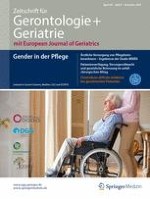26.10.2016 | CME
Clostridium-difficile-Infektion bei geriatrischen Patienten
Erschienen in: Zeitschrift für Gerontologie und Geriatrie | Ausgabe 8/2016
Einloggen, um Zugang zu erhaltenZusammenfassung
Clostridium difficile ist der häufigste Erreger nosokomialer antibiotikaassoziierter Diarrhöen bei Erwachsenen in Europa und Nordamerika. Die Clostridium-difficile-Infektion tritt typischerweise bei älteren Patienten mit Komorbiditäten und nach Antibiotikatherapie auf. Weitere Risikofaktoren sind u. a. Protonenpumpeninhibitoren, die viele ältere Patienten einnehmen. Als Hauptvirulenzfaktoren gelten Toxin A und B. Das klinische Spektrum reicht von der asymptomatischen Kolonisation über leichte Diarrhöen bis hin zu schweren Verläufen mit abdominellen Komplikationen oder Sepsis. Der diagnostische Goldstandard ist die Kultivierung, die aber im klinischen Alltag kaum praktikabel ist. Bewährt haben sich Glutamatdehydrogenase-, Toxin-A/B-Immunoassays und Polymerase-Kettenreaktion. Bei Erstinfektion oder Rezidiv kann Metronidazol, 3‑mal täglich 400–500 mg für 10 Tage, verabreicht werden. Bei erneuter Reinfektion, schwerwiegendem Verlauf oder mehreren positiven Prädiktoren sollte Vancomycin, 125 mg p.o. 4‑mal täglich für mindestens 10 Tage, gegeben werden. Fidaxomicin, Rifaximin, Stuhltransplantation oder monoklonale Antikörper stellen vielversprechende Therapiealternativen dar.
Anzeige















